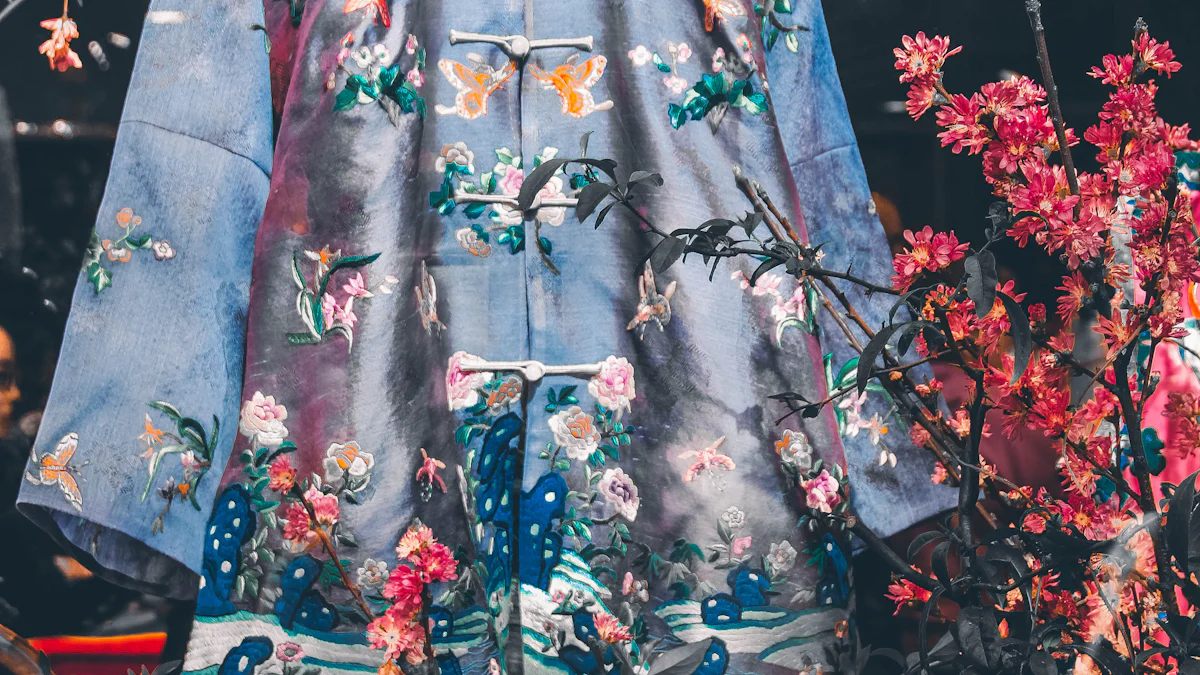
Exploring the Roots of Hanfu in Chinese History
Hanfu, the traditional attire of the Han Chinese, has a rich and storied history that dates back over three thousand years. Let’s delve into the ancient origins of Hanfu and its significance in Chinese rituals and ceremonies.
The Ancient Origins of Hanfu in Chinese
Hanfu has been an integral part of Chinese culture since ancient times, with its roots intertwined with legends and historical accounts. According to lore, the influence of the Yellow Emperor played a pivotal role in shaping the early forms of Hanfu. The Yellow Emperor is revered as a legendary sage king in ancient China, and his impact on Hanfu reflects its deep cultural significance.
Throughout various dynasties, including the Ming Dynasty, Hanfu underwent significant transformations that reflected the prevailing values and aesthetics of each era. During the Ming Dynasty, for instance, Hanfu took on a more conservative style due to the resurgence of Confucian values. This period saw a shift towards more modest designs, particularly for women, aligning with Confucian ideals of chastity and domesticity.
The most popular styles seeing a revival today are modern interpretations from prosperous periods in Chinese history such as the Tang, Song, and Ming dynasties. These revivals capture the essence of traditional Hanfu while incorporating contemporary elements to appeal to modern sensibilities.
Legends and Lore: The Yellow Emperor’s Influence
The legendary figure of the Yellow Emperor holds great significance in shaping early forms of Hanfu. His influence is deeply rooted in Chinese mythology and history, symbolizing wisdom and cultural heritage.
Hanfu Through the Dynasties: A Brief Overview
Hanfu was once predominant clothing attire until the Qing Dynasty when it experienced a decline. Characterized by loose, flowing robes, intricate embroidery, and distinctive layered designs, it represented an essential aspect of traditional Chinese fashion.
Hanfu in Chinese Rituals and Ceremonies
In addition to everyday wear, Hanfu plays a vital role in various rituals and ceremonies within Chinese culture. It holds particular importance in traditional weddings where it symbolizes cultural heritage and timeless elegance. Furthermore, during festivals and celebrations, individuals don vibrant Hanfu garments as a way to honor tradition while expressing their cultural pride.
The resurgence of Hanfu has sparked renewed interest among young people across China who seek to embrace their cultural roots through this ancient attire. With sales increasing by 146 percent year-on-year and an estimated 3.61 million people identifying themselves as Hanfu enthusiasts, there is no denying its growing popularity.
As we continue our exploration into the world of Hanfu, we will uncover its artistic elements that define this timeless fashion statement.
The Art and Aesthetics of Hanfu
As we continue our exploration of Hanfu, it’s essential to understand the elements that define this traditional Chinese fashion. From fabrics and materials to the evolution of styles, Hanfu embodies a rich cultural heritage and aesthetic appeal that resonates with modern sensibilities.
The Elements That Define Hanfu in Chinese Fashion
Fabrics and Materials: From Silk to Hemp
The choice of fabrics and materials is integral to the essence of Hanfu. Historically, silk has been a prominent fabric used in crafting these traditional garments. Its luxurious texture and lustrous sheen symbolize elegance and sophistication. Additionally, hemp, known for its durability and breathability, has also been a favored material for creating Hanfu attire. The use of these natural fibers not only reflects the craftsmanship of ancient artisans but also underscores the sustainable practices embedded in Chinese culture.
The Significance of Colors and Patterns
Colors and patterns play a pivotal role in defining the aesthetic appeal of Hanfu. Rich hues such as deep blues, vibrant reds, and earthy tones are often featured in these garments, each carrying symbolic significance rooted in Chinese culture. Furthermore, intricate patterns inspired by nature, mythology, and historical motifs adorn Hanfu, adding depth and storytelling to each ensemble.
The Evolution of Hanfu Styles
From Ancient Cuts to Modern Adaptations
The evolution of Hanfu styles spans centuries, reflecting shifting societal norms and artistic influences. Traditional cuts characterized by flowing robes with wide sleeves have endured through the ages, embodying gracefulness and freedom of movement. Over time, modern adaptations have emerged, blending traditional silhouettes with contemporary design elements to cater to diverse preferences while preserving the essence of Hanfu.
Influences from Other Cultures and Periods
The allure of Hanfu extends beyond its indigenous roots as it draws inspiration from diverse cultures and historical periods. Influences from neighboring regions such as Central Asia have contributed to the fusion of styles within Hanfu, showcasing the interconnectedness of ancient civilizations. Moreover, interactions with global trade routes have introduced new textiles and embellishments that have enriched the tapestry of Hanfu fashion.
The resurgence of Hanfu represents a captivating journey of cultural rediscovery and self-expression for individuals seeking to connect with their heritage through sartorial traditions.
Hanfu in Chinese Society Today
As we delve into the contemporary landscape of Hanfu in Chinese society, it becomes evident that this traditional attire has transcended mere fashion to become a flourishing movement deeply embedded in the cultural fabric of China.
The Resurgence of Hanfu in Chinese Youth Culture
The resurgence of Hanfu is closely intertwined with the power and reach of social media platforms, particularly on Weibo, where it boasts a staggering 1.8 million followers. Additionally, a Weibo ‘supertopic’ dedicated to Hanfu has garnered nearly half a million fans, underscoring the widespread appeal and influence of this cultural phenomenon. Shanghai-based content creator Shiyin has been at the forefront of this movement, regularly sharing captivating Instagram posts showcasing her adorned in flowing robes embellished with ornate embroidery. The hashtag #Hanfu has amassed over 4.89 billion views on Instagram to date, signifying its substantial impact on global audiences.
Social media platforms have played an instrumental role in popularizing Hanfu, with enthusiasts utilizing these channels to share images of themselves donning traditional garments, participating in cultural activities, and attending events. This digital community has not only fostered a deeper appreciation for China’s rich cultural legacy but also created a sense of belonging and camaraderie among individuals passionate about preserving their heritage.
The Hanfu Movement has provided a platform for younger generations to connect with and embrace Chinese culture authentically. By embracing Hanfu, individuals can express their cultural identity and reconnect with their roots, reflecting a growing confidence in self-expression among Chinese youths. This revival movement is driven by a desire to express national identity and pride while celebrating the enduring legacy of the largest ethnic group in China: Han.
Challenges and Controversies Surrounding Hanfu
Amidst its resurgence, the revival of Hanfu has sparked discussions surrounding authenticity and historical accuracy. As enthusiasts organize events such as fashion shows, tea ceremonies, and historical reenactments, questions arise regarding the faithful representation of traditional attire and customs. Furthermore, as Hanfu gains international attention through festivals and events attracting participants from around the world, debates ensue regarding its portrayal on the global fashion scene.
The popularity surge is attributed to increasing social media exposure by amateurs who study and proudly wear Hanfu in public spaces. This newfound visibility has propelled Hanfu into mainstream consciousness both domestically and internationally.
My Personal Journey with Hanfu
Discovering Hanfu in Chinese
As I embarked on my personal journey with Hanfu, I discovered that wearing this traditional attire offered me a tangible connection to my heritage. It was more than just clothing; it became a way for me to express my cultural identity and reconnect with the rich traditions of my ancestors. The allure of Hanfu extended beyond its aesthetic appeal, resonating deeply with my desire to embrace and celebrate my Chinese heritage.
My First Hanfu: A Story of Connection
My passion for Hanfu was ignited by friends who shared a profound appreciation for traditional Chinese clothing. Their enthusiasm and knowledge about the cultural significance of Hanfu inspired me to delve deeper into its history and acquire my first Hanfu costume. As I adorned the flowing robes embellished with intricate embroidery, I felt an undeniable sense of pride and belonging, as if I were embodying the timeless elegance of generations past.
Learning the Cultural Nuances
Through my exploration of Hanfu, I gained valuable insights into the cultural nuances embedded within each garment. Wearing Hanfu not only allowed me to express my cultural identity but also provided a gateway to understanding the customs, rituals, and symbolism woven into every fabric and pattern. It became a journey of self-discovery, enabling me to appreciate the depth of Chinese traditions while fostering a profound sense of connection to my roots.
Hanfu in My Life: Beyond Clothing
As Hanfu transcended mere attire, it evolved into a transformative experience that extended beyond clothing, shaping various aspects of my life.
Hanfu and Community: Finding a Sense of Belonging
The resurgence of Hanfu has created a vibrant community where individuals passionate about preserving their heritage come together to celebrate their shared love for traditional Chinese culture. Through attending events, engaging in cultural activities, and connecting with like-minded individuals, I found a sense of belonging that transcended geographical boundaries. The camaraderie within this community fostered meaningful connections and friendships, underscoring the unifying power of Hanfu as a symbol of cultural pride and heritage.
The Future of Hanfu in My Perspective
Reflecting on my personal journey with Hanfu, it is evident that this revival movement represents more than just a fashion statement; it embodies a profound reconnection with our cultural legacy. As we look towards the future, I envision Hanfu continuing to serve as a bridge between generations, fostering an enduring appreciation for our rich heritage while empowering individuals to embrace their cultural identity authentically.
In conclusion, my personal journey with Hanfu has been an enriching odyssey that has deepened my understanding of Chinese traditions while instilling in me a profound sense of pride in our cultural heritage.
Source: Narratives from Liang Ming, Liu, Shiyin






